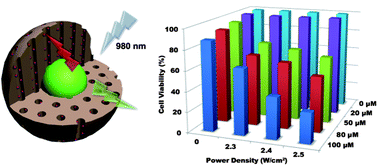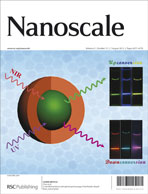Triple-functional core–shell structured upconversion luminescent nanoparticles covalently grafted with photosensitizer for luminescent, magnetic resonance imaging and photodynamic therapy in vitro†
Abstract
Upconversion luminescent nanoparticles (UCNPs) have been widely used in many biochemical fields, due to their characteristic large anti-Stokes shifts, narrow emission bands, deep tissue penetration and minimal background interference. UCNPs-derived multifunctional materials that integrate the merits of UCNPs and other functional entities have also attracted extensive attention. Here in this paper we present a core–shell structured nanomaterial, namely, NaGdF4:Yb,Er@CaF2@SiO2-PS, which is multifunctional in the fields of photodynamic therapy (PDT), magnetic resonance imaging (MRI) and fluorescence/luminescence imaging. The NaGdF4:Yb,Er@CaF2 nanophosphors (10 nm in diameter) were prepared via sequential thermolysis, and mesoporous silica was coated as shell layer, in which photosensitizer (PS, hematoporphyrin and silicon phthalocyanine dihydroxide) was covalently grafted. The silica shell improved the dispersibility of hydrophobic PS molecules in aqueous environments, and the covalent linkage stably anchored the PS molecules in the silica shell. Under excitation at 980 nm, the as-fabricated nanomaterial gave luminescence bands at 550 nm and 660 nm. One luminescent peak could be used for fluorescence imaging and the other was suitable for the absorption of PS to generate singlet oxygen for killing cancer cells. The PDT performance was investigated using a singlet oxygen indicator, and was investigated in vitro in HeLa cells using a fluorescent probe. Meanwhile, the nanomaterial displayed low dark cytotoxicity and near-infrared (NIR) image in HeLa cells. Further, benefiting from the paramagnetic Gd3+ ions in the core, the nanomaterial could be used as a contrast agent for magnetic resonance imaging (MRI). Compared with the clinical commercial contrast agent Gd–DTPA, the as-fabricated nanomaterial showed a comparable longitudinal relaxivities value (r1) and similar imaging effect.


 Please wait while we load your content...
Please wait while we load your content...